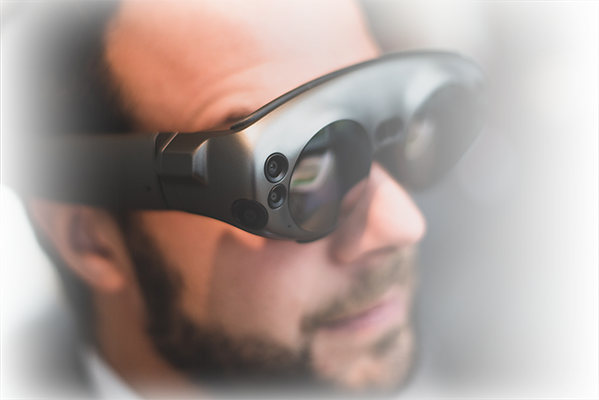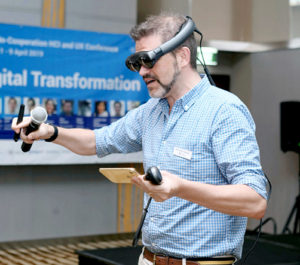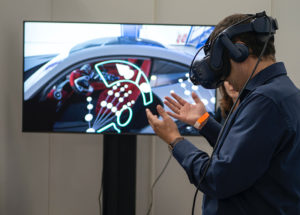
Enhance Communications and Increase Engagement with Customers in the Metaverse for B2B
- By Jason Turner
- February 5, 2023
In case you’ve been vacationing on an exclusive island for the last few years, the Metaverse is a virtual world full of exciting opportunities for businesses and customers alike. With its rapidly growing population and adoption by some of the world’s leading brands, the Metaverse has become a valuable platform for customer engagement and communication, in both B2C and B2B markets.
To help your business or clients make the most out of these opportunities, you must be able to effectively communicate the value of taking their brand story and engaging customers in meaningful conversations in this new, and still early stage, of Web3 technology.
Is the Metaverse a Game Changer for B2B Marketing?
 Yes! Emphatically yes! The time is now for you (marketer or business leader) to capitalize on the Metaverse’s potential as a powerful channel for customer engagement and communication. Now that businesses can build virtual worlds that replicate their physical stores, consider giving customers virtual tours of current or future products, or have live events with customers in a uniquely or co-created venue.
Yes! Emphatically yes! The time is now for you (marketer or business leader) to capitalize on the Metaverse’s potential as a powerful channel for customer engagement and communication. Now that businesses can build virtual worlds that replicate their physical stores, consider giving customers virtual tours of current or future products, or have live events with customers in a uniquely or co-created venue.
Businesses, priding themselves as early adopters, are taking advantage of the Metaverse’s interactive capabilities to create immersive experiences through avatars, 3D objects, and audio-visual compositions that lure the user into an immersive experience that not only entertains but builds a lasting impression on customers or prospects. Imagine playing the latest dystopian RPG and encountering an old, weathered bottle of that favorite refreshing beverage or a vintage Macintosh sitting on a desk. It’s coming and, in some cases, already here.
These trendsetters are creating connections with like-minded people, hosting events, and even developing communities around their brand or product. We’re just scratching the surface of how companies demonstrate their enthusiasm for engaging with customers on an intimate level while also generating valuable feedback from their most passionate users.
Leveraging this newly burgeoning technology, businesses provide unique opportunities for customers to interact with their brand in ways that are not possible in just the physical store or their website.
The possibilities are virtually endless — but it’s up to us as marketers to create a strategy that best aligns with the company objectives.
3D Visualizations for B2B Marketing
 Remember the soda and Mac analogy? Using 3D visualization as part of strategic marketing efforts can help businesses make a host of products or services memorable. By creating 3D avatars or interactive objects, companies can effectively showcase their products or services in an immersive environment that encourages interaction from customers. With the advancement of artificial intelligence (AI) technology, businesses can create personalized experiences designed to meet individual consumer needs, create scenarios around buying personas, or test new product concepts while also providing useful feedback to marketers on customer behavior patterns.
Remember the soda and Mac analogy? Using 3D visualization as part of strategic marketing efforts can help businesses make a host of products or services memorable. By creating 3D avatars or interactive objects, companies can effectively showcase their products or services in an immersive environment that encourages interaction from customers. With the advancement of artificial intelligence (AI) technology, businesses can create personalized experiences designed to meet individual consumer needs, create scenarios around buying personas, or test new product concepts while also providing useful feedback to marketers on customer behavior patterns.
3D visualization can be a powerful tool for product development and customer service. Businesses can use 3D models to prototype new products or services before investing significant resources in production. They can also provide a better understanding of how their existing products are being used by clients through detailed customer feedback analysis. This type of insight could lead to improved products and customer support experiences that will further build loyalty towards the brand.
From AR to XR: Exploring Acronyms
 Virtual reality (VR) and Augmented reality (AR) have become increasingly popular search terms over the past few years. While the technology is still evolving, it has already made an impact in many industries and more are emerging everyday. So gear up and get ready, we’re not in Kansas anymore. Or are we?
Virtual reality (VR) and Augmented reality (AR) have become increasingly popular search terms over the past few years. While the technology is still evolving, it has already made an impact in many industries and more are emerging everyday. So gear up and get ready, we’re not in Kansas anymore. Or are we?
So we are on the same page here are some important definitions you’ll need to know as we take our journey together.
Virtual Reality
Virtual reality (VR) is a computer-generated simulated environment that allows viewers to experience something through the use of various technologies, such as wearable headsets and gloves. VR offers an immersive experience for users, allowing them to be fully immersed in a virtual world with realistic visualization and sound. This technology has been used for many years in several industries, including gaming and training simulations.
Augmented Reality
Augmented reality (AR) is similar to virtual reality, but instead of creating a simulated environment from scratch, it overlays computer-generated visuals on top of the user’s actual surroundings. This allows users to interact with digital objects as if they are real and can be used to enhance various activities such as education, gaming, and sports. AR is also being utilized in several industries , including healthcare and retail.
Mixed Reality
Mixed reality (MR) is a combination of virtual and augmented reality. It combines the simulated environment of virtual reality with the real world in order to create an immersive experience. MR technology has been used for several different purposes, such as providing enhanced experiences in gaming, making training simulations more realistic , and creating immersive experiences for entertainment purposes.
Extended Reality
Extended reality (XR) is an umbrella term that refers to all technologies related to virtual, augmented, and mixed reality. It can be used to refer to the hardware and software associated with these technologies as well as the content created using them. XR technology is being used in a variety of industries, from health care to retail, to create immersive experiences and improve efficiency. XR can be used to provide virtual tours of products before they’re purchased, enable remote medical consultations, or even enable remote engineering inspections.
The combination of VR, AR, and MR technologies is creating new opportunities for businesses across the globe. XR technology has the potential to revolutionize how people work, play, learn and interact with each other by providing immersive experiences that wouldn’t be possible otherwise. Companies large and small are exploring how XR can help them improve customer engagement and productivity while reducing costs.
XR is already being used for marketing purposes. With an XR headset, companies are able to create interactive experiences that feature products in use, or even let users explore a simulated environment with the product in it. This can be used to create consumer interest, as well as demonstrate the product’s features and capabilities more effectively than with traditional marketing methods.
Creating Targeted Ads and Content in the Metaverse
 What about the forms of marketing and advertising, we as marketers, already know? Can XR be used to target customers and audiences within virtual worlds?
What about the forms of marketing and advertising, we as marketers, already know? Can XR be used to target customers and audiences within virtual worlds?
The answer is yes. By using AR, VR, and MR technologies together with 3D content, marketers can create immersive experiences that serve up targeted ads, sponsored content, product placement, and compelling storylines.
This type of marketing can allow businesses to engage with their audience in a new way; allowing them to connect on a deeper level than ever before. It also allows for hyper-targeted messaging that can reach individuals or groups based on their demographic data or interests.
Allowing Customers to Try Before They Buy
A big benefit of XR technology is the ability for customers to try products before they buy them. For example, say you are a battery storage manufacturer that sells industrial and home battery backup and energy storage systems. With XR, customers could see the optimal location for the system and how the system would look in their facility or home; they can see how it looks and more importantly, how it will impact the use of the space around your product.. This can help reduce planning costs, customer complaints and change orders – all of which are costly for your businesses.
 XR can help with sales engagements, delivering an enhanced face to face sales experience. This is particularly useful for complex B2B sales cycles or in situations where customers need more time to make decisions. XR technology can be used to create a sense of presence with the customer, even if they are not physically present.
XR can help with sales engagements, delivering an enhanced face to face sales experience. This is particularly useful for complex B2B sales cycles or in situations where customers need more time to make decisions. XR technology can be used to create a sense of presence with the customer, even if they are not physically present.
Finally, XR technology can help businesses track and personalize their marketing campaigns in real-time. It can provide insights into how customers interact with products and services, allowing brands to tailor messaging that can reach individuals or groups based on their demographic data or interests. This kind of customized information makes it much easier for businesses to target specific audiences with relevant content that resonates with customers – giving you an advantage over competitors who are stuck using traditional methods of marketing.
Companies Leading the Way Into New Worlds
There are a number of companies that are considered early adopters of the metaverse. These companies are helping to shape the future of this new digital world, both in terms of technology development and social implications. Some of the most notable players include:
- BofA: Bank of America employs more than 50 thousand employees, most of which need to learn new skills quickly. Traditional e-learning methods, where employees simply click through, do not produce the needed results. That’s why the bank is using virtual reality (VR) training instead.
BofA uses VR to train staff on how to open accounts, as well as more difficult tasks like conducting a service call. Artificial intelligence (AI) is used in conversations with customers to simulate responses based on the answer given. Employees learn this way to perform professionally in situations where emotion is an important factor, such as applying for a loan.
- KB Homes: Developed and launched in 2020, KB Homes is a virtual world that allows players to customize their own house or explore the world with friends. It includes an array of customization options including furniture, wallpapers, floor plans and much more. KB Homes also has an in-game economy where users can purchase items with Robux (the currency used within the game) and make real-time trades with other players. KB Homes is a great virtual world for those looking to escape reality or just have some fun playing games with friends.
- Molehill: Molehill is an interactive, educational platform that focuses on teaching kids in a safe environment. It features 3D worlds where children can learn about biology, physics, mathematics, chemistry and more. The game includes mini-games, quizzes and projects which will help kids develop their knowledge. Players can also take part in virtual events such as global competitions and mission challenges to earn rewards. Molehill is a great way for kids to explore their world in a safe and interactive manner.
- Google: Through its various platforms – including Street View, Google Earth and Daydream – Google has been a leader in providing immersive experiences. The company is also exploring ways to integrate virtual reality into its products, making it easier for users to explore new places and experiences in a more interactive and engaging format.
- Facebook: The social media giant has been at the forefront of virtual worlds since launching its Oculus Rift headset in 2016. Now, with the release of its Spaces platform, Facebook is pushing further into the metaverse, allowing people to virtually hangout, create and explore new worlds.
- Microsoft: The tech giant is active in both the augmented and virtual reality space, with its HoloLens headset providing a way for users to interact with holograms. Additionally, Microsoft has been developing its own Metaverse – called Project X-Ray – which is being built on the company’s azure platform.
- DHL: DHL aims to make the loading of goods as efficient as possible to save money and space. Therefore, the company decided to educate logistics employees using a “Cargo Loading VR Simulation.
During the training, employees learn how to organize packages as efficiently as possible, and the application labels any unused space so the employee can see where they are leaving space.
The training has a time limit and a leaderboard with other employees’ times on it, keeping the team motivated to train and improve.
Virtual reality training improved employee performance and reduced strain 99 percent of the time. DHL now uses fewer cars to transport more packages, reducing carbon emissions and costs.
- Epic Games: Epic Games has been developing its own metaverse – the MetaVerse – for some time now. It utilizes the unreal engine 4 to create a highly detailed and immersive world with real time physics, lighting and shading effects.
- Robolox: Roblox is a game-creation platform that allows users to create, share and play user-generated 3D games. Unlike other virtual worlds, Roblox has a single unified universe shared by all players in the world. The platform also supports multiplayer action, allowing people from all over the world to join forces and tackle tough challenges together.
- Sansar: Sansar is a virtual world created by Linden Lab, the same people behind Second Life. It’s powered by Unreal Engine 4 and supports powerful features such as real-time 3D rendering, advanced physics simulation, voice chat and facial animation. As with other virtual worlds, users can create their own experiences or explore content created by others. Unlike Second Life, Sansar is focused more on gaming and interactive experiences. It’s also cross-platform, allowing players to access the virtual world from their PC or VR headset.
And the list goes on with new companies and platforms popping up in the Metaverse. Many of these platforms are working together to create interoperability between different virtual worlds. This allows users to move around the Metaverse, visiting one world to the next.
Are You Ready to Enter an Alternate Reality?
So what will you do as a marketer? The world of marketing and customer engagement is quickly shifting from a manual to an automated process. Prepare yourself and your clients for this movement by exploring the possibilities that an alternate reality offers. Augmented reality and virtual reality can be used to introduce a new level of reach, customer engagement and interaction, allowing businesses to reach larger groups of potential customers with more personalized messaging.
The opportunities are limitless when it comes to augmented and virtual reality B2B marketing. From using 3D models or videos to demonstrate products in a much more realistic way than traditional print or web-based ads, to creating interactive experiences for sales prospects that use their own data, there is no limit on what you can do.
Take advantage of this technology now and start planning for the future – it’s time to give your clients and your business a competitive edge!
